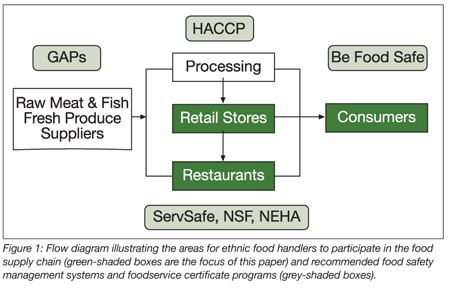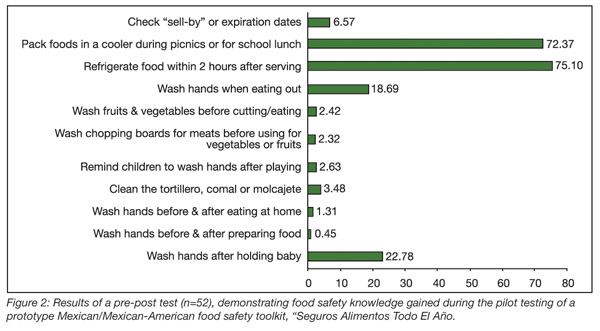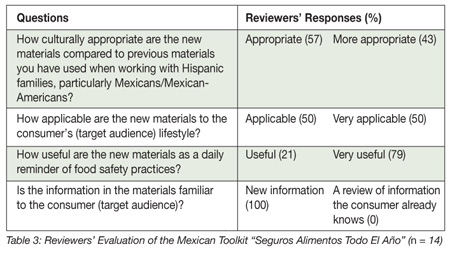The U.S. is projected to become more racially and ethnically diverse by mid-century, with the working-age population projected to become 55% of what used to be considered the minority.[1] As minority groups continue to play an increasing role in the workforce of the U.S. food supply chain,[2] there is a need to develop effective food safety education training resources for ethnic food handlers.
The expanding ethnic populations and increased prevalence of ethnic food markets have been accompanied by a proliferation of ethnic foodservice establishments and retail stores in the U.S., with Mexican and Asian cuisines ranking as the top two popular ethnic foods.[3] Not surprisingly, the U.S. Centers for Disease Control and Prevention reported an increase in total food outbreaks associated with ethnic foods from 3% to 11% from 1990 to 2000, with most frequent outbreaks representing Mexican (41%), Italian (39%) and Asian (20%) foods. The highest number of outbreaks were reported to have occurred in restaurants (43%) and private homes (21%).[3]
In a study of independently owned restaurants, a significantly higher number of food safety violations (e.g., inadequate time and temperature control, lack of hand washing) were found in ethnic restaurants (particularly Asian) than in non-ethnic restaurants.[4] Ethnic food retail stores have also been involved with a number of critical/priority food violations,[5,6] including inadequate temperatures during transport, holding and storage and cross-contamination. As energy costs continue to increase, more ethnic food distributors may try to cut corners by using transport and storage environments that have minimal temperature control, posing a food safety risk.[7]
Traditional food safety educational resources targeting ethnic audiences are usually direct translations of the English food safety materials into another language. These direct or literal translations we refer to as Level 1 ethnic food safety resources, containing mainly the 4 Cs (clean, don’t cross-contaminate, cook, chill) or the U.S. Department of Agriculture Food Safety and Inspection Service (USDA FSIS) Be Food Safe messages, are aimed at a general audience. These resources may not necessarily be culturally appropriate to some ethnic populations and may not have gone through a process that solicited feedback from all potential stakeholders.
This paper discusses strategies for improving ethnic food safety educational resources using Level 2 (culturally appropriate) and Level 3 (need-directed, process-oriented) approaches. For the purposes of this paper, the examples are focused primarily on Mexican and Asian audiences. However, the strategies are applicable to other ethnic populations in the U.S.
Strategies for Ethnic Food Safety Education
The strategies recommended in subsequent sections were based on our previous experience in developing prototype food safety educational resources targeting ethnic groups. The prototype toolkits were composed of a curriculum and visual aids for the educator/food safety communicator and promotional educational resources handed out to the ethnic participants of food safety classes. These resources can be downloaded from www.fooddomain.msu.edu. Special focus was made on the consumer food safety toolkit for Mexicans/Mexican-Americans, Seguros Alimentos Todo El Año (Safe Food All Year Round), the first prototype ethnic food safety toolkit we developed following the strategies discussed in this paper. However, subsequent ethnic food safety prototype toolkits (Table 1)[8] are mentioned to further illustrate recommended strategies.

 Strategy 1: Consider the Ethnic Food Safety System to Determine the Target Audience
Strategy 1: Consider the Ethnic Food Safety System to Determine the Target Audience
Food safety systems help identify sanitary and hygiene-related risks in the various stages of the food system, allowing for preventative measures and food safety interventions.[9] Figure 1 illustrates the components of a typical food system applied to the distribution of ethnic foods from suppliers to consumers. It also shows various foodservice certificate programs [e.g., ServSafe, NSF, National Environmental Health Association (NEHA)], food safety management programs [e.g., Good Agricultural Practices (GAPs) Hazard Analysis and Critical Control Points (HACCP)] and consumer food safety resources (e.g., Be Food Safe) that are already widely available. Much work has already been done by Cornell University on GAPs targeting Hispanic migrant workers.[10] For food processing industries, food safety programs like HACCP typically are offered either in-house or by institutions and private consultants. Our efforts were focused on ethnic consumers and food handlers in ethnic restaurants and retail stores where we saw a need. We believe that food handling habits and hygiene practices of ethnic food handlers are influenced by their cultures of origin that start at home as consumers, which may then be carried over into the workplace. Many ethnic start-up retail and foodservice operations function without the benefit of a large corporate support structure.[7] Using a food systems approach to ethnic food safety education can foster connectivity and continuity of initiatives and efforts, address any gaps and encourage collaborations, thereby avoiding reinventing the wheel.
Strategy 2: Know Your Target Ethnic Audience
A typical mistake when designing food safety educational programs is thinking that ethnic populations are a homogeneous group. When targeting a particular ethnic group for a food safety education program, one should be mindful of cultural distinctions to avoid stereotyping. Being familiar with the food cultures of ethnic populations and being sensitive to their accepted customs of communication can help improve the delivery of food safety messages. Each ethnic group has its own culinary preferences. Among Hispanics, Cubans use black beans; Puerto Ricans prefer pinto beans; Central South Americans and Hispanic Caribbean populations use red kidney beans.[11] Chinese cuisine still dominates the U.S. market, but other Asian (e.g., Japanese, Korean and Thai) and emerging (Indian and Vietnamese) restaurants are popular. We cited Mexican and Cuban dishes in the resources targeting Mexican migrants and Cuban refugees/New Americans, respectively.
Strategy 3: Know the Level of Acculturation of the Target Ethnic Audience
Diverse ethnic groups from various countries demonstrate cultural differences influenced by their educational and economic circumstances and their assimilation into various regional cultures in the U.S.[11] The design and mode of communication of the food safety messages should consider the degree of acculturation of the ethnic group. Acculturation is the process of acquiring a second culture, measured by factors including the length of U.S. residency, ties to country of origin, language use, food customs and interpersonal network composition. Ethnic food preferences, purchasing, cooking practices and food consumption patterns differ based on the level of acculturation.[12] According to Lecos,[5] first-generation owners and operators of ethnic family-owned stores and restaurants tend to be unfamiliar with food safety and sanitation standards, and commit higher risk violations. Some older generation operators regard lower inspection grades (e.g., “B”) as a badge of honor and an indication of being more authentic.[13] Typically, these ethnic individuals still prefer to speak in their native tongue, shop at traditional places (e.g., Mexican carnecerias; Oriental stores), cook authentic dishes and cling to traditional food habits and handling practices. For these ethnic audiences, traditional modes of communication need to be observed, and food safety resources must be culturally appropriate and translated into their native language. On the other hand, educational resources in English can be used for third-generation or U.S.-born ethnic individuals because they speak English and are usually bilingual. Some younger generation family members who took over family-owned food businesses have even modernized their facilities to more fully comply with food safety and sanitation standards in the U.S.
Strategy 4. Know the Educational Attainment of the Target Ethnic Audience
Knowing the educational attainment of your audience helps determine the literacy level to use in the development of educational resources. For instance, our target ethnic families typically had completed high school. Therefore, we utilized more illustrations and photos, with little text. According to Schmidt,14 information-rich visual explanations like images, cartoons, video clips and samples enhance learning for a low-literacy level audience compared to using verbal and/or textual explanations alone.
Strategy 5. Use the Appropriate Translation for the Target Ethnic Audience
Ethnic populations are a heterogeneous group, so consider the appropriate language or dialect to use during translation. There are even variations in spoken Spanish among Hispanic groups. When we targeted Mexicans/Mexican-Americans, we tapped the expertise of a Mexican Spanish-speaking translator. In another project for Cuban refugees/New Americans and Puerto Ricans, we worked with translators of Cuban and Puerto Rican descent, respectively. Several dialects can exist within each Asian country, so using a national language that can be understood by the majority is recommended. The resource we developed for Chinese food handlers was translated into Mandarin, regarded as the national language.
Strategy 6: Customize Ethnic Food Safety Educational Resources
A customized or tailor-made approach (Level 2) is more relevant then a “one-size-fits-all approach,” typical of the traditional direct or literal translation (Level 1) type of ethnic educational resources. A Level 2 approach modifies existing food safety resources by utilizing culturally appropriate examples or illustrations to which ethnic audiences can easily relate. For example, the prototype food safety toolkit we developed targeting Mexicans/Mexican-American consumers, “Safe Food All Year Round” (Seguros Alimentos Todo El Año), was designed around the fiesta theme.[8] Mexicans enjoy celebrating fiestas (lively festivities in honor of various patron saints) involving food gatherings. Festive, bright and bold colors characteristic of the Mexican culture were reflected in the choice of photos utilized. We also featured details intended to make the resources culturally sensitive, including ristra (bundle of dried red peppers commonly hanging in Mexican kitchens) and a crucifix (display of religious icons is usual in Mexican homes).
 Educational toolkits we designed for ethnic food handlers in Mexican and Asian restaurants included food safety topics applicable to a restaurant setting (Table 2). The first food safety topic covered was on personal employee hygiene, to purposely link to recommended consumer food safety and hygiene practices at home. Many food safety problems introduced or transmitted are linked to poor hygiene practices by food handlers.[15-18] The need for a Consumer Advisory when serving raw food like ceviche (Mexican) and sashimi (Japanese/Korean) was included as a topic as were food allergens, considering that many ethnic dishes contain food allergens,[19] and most are not aware of them (e.g., Mexican mole and Thai pad thai and satay dishes contain peanuts).
Educational toolkits we designed for ethnic food handlers in Mexican and Asian restaurants included food safety topics applicable to a restaurant setting (Table 2). The first food safety topic covered was on personal employee hygiene, to purposely link to recommended consumer food safety and hygiene practices at home. Many food safety problems introduced or transmitted are linked to poor hygiene practices by food handlers.[15-18] The need for a Consumer Advisory when serving raw food like ceviche (Mexican) and sashimi (Japanese/Korean) was included as a topic as were food allergens, considering that many ethnic dishes contain food allergens,[19] and most are not aware of them (e.g., Mexican mole and Thai pad thai and satay dishes contain peanuts).
Strategy 7: Use a Need-directed, Participatory and Process-oriented Approach
An even more ideal type of approach would be what we refer to as Level 3, that is, developing culturally appropriate and customized ethnic food safety resources (Level 2) using a need-directed, process-oriented and participatory approach. The recommended Level 3 process includes the following steps: a) conduct a baseline/needs assessment survey on food safety; b) design the prototype food safety educational resource; c) convene a focus group to evaluate the draft; d) modify the draft based on feedback of the focus group; e) pilot test the prototype toolkit with the target audience and have it reviewed by educators/food safety communicators; f) further modify the prototype if needed, based on the evaluation and review; and g) reproduce for mass distribution. While this process may be expected for any educational program, it is not usually implemented as such.
The inclusion of promotional educational resources was specified in a needs assessment survey we conducted among extension educators. The development of educational resources focusing on Asian and Mexican food handlers was in response to food safety issues identified by food inspectors/regulators with these ethnic restaurants (State of Michigan food regulators and local food inspectors, personal communication).[6,20]
When working with ethnic populations, a process-oriented approach is imperative because it encourages the participation of the educators/food safety communicators and the target audience, making the resources culturally appropriate while addressing expressed needs. For example, a program associate requested “portable” promotional resources for transient and mobile migrant Mexican clients; hence, we designed functional resources (e.g., calendar, shopping notepad) to contain food safety messages they could take with them on-the-go.
Focus group findings are valuable to researchers in early stage product development and useful for identifying the most practical outcomes.[21] The initial draft of our Mexican prototype toolkit was reviewed by a focus group consisting of extension educators/program associates (n = 7) who were either bilingual or working with Hispanic families. Their feedback helped further improve the prototype (Level 3). An example of a suggestion considered was the changing of the cartoon mascot from a male character wearing a huge sombrero to a female mascot with braided hair typical of young Mexican girls. Apparently, depicting Mexicans with a sombrero is considered by Mexican-Americans as a form of stereotyping them as lazy.
Effectiveness of Strategies
The effectiveness of the recommended strategies was evaluated through pre- and post-testing and review of the prototype Mexican food safety toolkit.
Pre-Post Evaluation
 Results of a pre-post evaluation conducted during the pilot testing of the prototype toolkit by ethnic participants (n = 52) are summarized in Figure 2. The most notable improvement in food safety knowledge (75.1%) was the realization of the importance of refrigeration. It is not an unusual practice in this culture (and other cultures from developing countries with limited refrigeration facilities) to leave food out at room temperature longer than 2 hours. Another positive knowledge change was realizing the importance of keeping foods cold or hot when traveling or packing picnics or lunchboxes (72.4%). These top two behavior changes both indicate the lack of appreciation for the importance of refrigeration or cooling by this particular ethnic audience. They are also examples of cultural food habits at home that can translate into risky food handling practices at work in restaurants or retail food stores. The data indicate that food safety messages are appreciated and understood with the use of culturally appropriate examples the ethnic audience could relate to, and that if these messages are internalized, they may eventually translate into improved food safety practices.
Results of a pre-post evaluation conducted during the pilot testing of the prototype toolkit by ethnic participants (n = 52) are summarized in Figure 2. The most notable improvement in food safety knowledge (75.1%) was the realization of the importance of refrigeration. It is not an unusual practice in this culture (and other cultures from developing countries with limited refrigeration facilities) to leave food out at room temperature longer than 2 hours. Another positive knowledge change was realizing the importance of keeping foods cold or hot when traveling or packing picnics or lunchboxes (72.4%). These top two behavior changes both indicate the lack of appreciation for the importance of refrigeration or cooling by this particular ethnic audience. They are also examples of cultural food habits at home that can translate into risky food handling practices at work in restaurants or retail food stores. The data indicate that food safety messages are appreciated and understood with the use of culturally appropriate examples the ethnic audience could relate to, and that if these messages are internalized, they may eventually translate into improved food safety practices.
Evaluation by Reviewers
 Table 3 summarizes the review of the prototype toolkit by extension educators/program associates (n = 14). The prototype was considered by 43% of the reviewers as culturally “more appropriate” compared to previous materials they had used with Hispanic families. Half of the respondents considered the new materials “very applicable” to the target audience’s lifestyle, and the other 50% rated the resources “applicable.” About 79% rated the prototype materials as “very useful” as a daily reminder of food safety practices. All the reviewers (100%) regarded the information and presentation as new for the target audience, with the inclusion of additional food safety messages besides the traditional consumer food safety messages they had been delivering in their food safety classes.
Table 3 summarizes the review of the prototype toolkit by extension educators/program associates (n = 14). The prototype was considered by 43% of the reviewers as culturally “more appropriate” compared to previous materials they had used with Hispanic families. Half of the respondents considered the new materials “very applicable” to the target audience’s lifestyle, and the other 50% rated the resources “applicable.” About 79% rated the prototype materials as “very useful” as a daily reminder of food safety practices. All the reviewers (100%) regarded the information and presentation as new for the target audience, with the inclusion of additional food safety messages besides the traditional consumer food safety messages they had been delivering in their food safety classes.
Conclusions
It is the intent of the authors that educational resource designers and food safety educators/communicators benefit from the recommended strategies that go beyond the traditional literal or direct translation (Level 1) when targeting ethnic audiences. These strategies include knowing the target audience (identify ethnic group, level of acculturation and educational attainment and use of appropriate translation), customizing the food safety educational resources so they are culturally appropriate or sensitive (Level 2) and following a need-directed, process-oriented, participatory approach (Level 3).
We thank the following for providing financial support: MSU Extension’s (MSUE) Multicultural Action Mini-Grants for the development of the ethnic consumer prototypes, the MSUE Area of Expertise Competitive Mini-Grants and the USDA’s Food Stamp Nutrition Education Program for the piloting of the Mexican toolkit and resources for refugees. We also thank the Michigan Department of Agriculture for the development of the prototype resources for ethnic restaurants.
Lillian G. Po, Ph.D. is an adjunct associate professor at the University of Missouri in Columbia, MO. She obtained her Ph.D. in Food Science from Michigan State University (MSU). She teaches graduate online courses on ethnic foods and food safety. She has developed training curricula and presented food safety programs targeting ethnic audiences. She is also consulting for industry around food processing, food quality and safety issues. She can be reached at pol@missouri.edu.
Leslie D. Bourquin, Ph.D. is a professor and food safety specialist in the Department of Food Science and Human Nutrition at MSU. He also holds appointments in the Center for Advanced Studies in International Development and the Center for Integrative Toxicology at MSU. His research program focuses on the impacts of public and private food safety standards, barriers to their acceptance and effective implementation by the food industry, and the efficacy of these standards to protect public health. His outreach and development work focuses on applied research, capacity development and risk communication on food safety issues. He has worked extensively on international food and agriculture development projects in numerous countries. He can be reached at bourqui1@msu.edu.
Luis G. Occeña, Ph.D. is chair of the Department of Industrial and Manufacturing Systems Engineering at the University of Missouri in Columbia, MO. He obtained his Ph.D. in Industrial Engineering from Purdue University. His research experience and interests include Scalable Systems and Information Integration, Computer-aided Process Modeling, Product Life Cycle Management, Industrial Automation and Industrial Engineering applications in healthcare, energy, food and manufacturing systems. He teaches courses in Computer-aided Design and Manufacturing and Entrepreneurship and Innovation Management. He can be reached at occenal@missouri.edu.
Edgar C. Po, Ph.D. obtained his Ph.D. in Crop and Soil Sciences as a Fulbright scholar at MSU, where he managed the Food Domain website. He completed his post-doctoral training at the Department of Industrial and Manufacturing Systems Engineering at the University of Missouri in Columbia, MO, where he was involved with research in ethnic food safety transport. He is now consulting in the Philippines for industry and government in the area of precision agriculture. He can be reached at poe@missouri.edu.
References
1. www.census.gov/PressRelease/www/releases/archives/population/012496.html.
2. Simonne, A. H., A. Nille, K. Evans and M. R. Marshall. 2004. Ethnic food safety trends in the United States based on CDC foodborne illness data. Food Prot Trends 24:590-604.
3. reports.mintel.com/sinatra/reports/search_results/show&&type=RCItem&page=0&noaccess_page=0/display/id=393433.
4. www.fsis.usda.gov/PDF/Atlanta2010/ Slides_FSEC_JKwon.pdf.
5. Lecos C.W. 1986. Imported ethnic foods, exotic fare but buyers beware. FDA Consumer 20 December-January.
6. Wojtala, G. 2007. Multi-state food & agriculture truck transportation project. AFDO 111th Annual Educational Conference, San Antonio, TX.
7. Gapud V. 2010. Food safety trends in retail and food service. Food Safety Magazine 15(6):28-32.
8. fooddomain.msu.edu/food%20safety%20toolkit.htm.
9. Dong, F. and H. H. Jensen. 2008. Sanitation and hygiene deficiencies as contributing factors in contamination of imported foods. In Imported foods—Microbiological issues and challenges, eds. Doyle M. P. and M. C. Erickson, 139-158. Washington, DC: American Society for Microbiology Press.
10. wcmorris.com/gap/files/cornell_guide.pdf.
11. Hollingsworth P. 2003. Hispanic market shows huge potential. J Food Technol 57:26-30.
12. Pugesek B. 2007. Exploration of Hispanic culture and flavor—Revisited. Paper presented at the 2007 Annual Meeting and Food Expo of the Institute of Food Technologists. July 30, 2007. Chicago, IL.
13. www.streetdirectory.com/food_editorials/cuisines/international_cuisine/are_ethnic_restaurants_and_markets_more_hazardous.html.
14. Schmidt S. J. 2009. Development and use of visual explanations: Harnessing the power of the “seeing” brain to enhance student learning. J Food Sci Ed 8(3):68-72.
15. Green L., C. Selman, A. Banerjee, R. Marcus, C. Medus, F. J. Angulo, V. Radke, S. Buchanan, EHS-Net Working Group. 2005. Foodservice workers’ self-reported food preparation practices: An EHS-Net Study. Int J Hyg Environ-Health 208:27-35.
16. www.cdc.gov/mmwr/preview/mmwrhtml/ss5510a1.htm.
17. Hedberg C. W., S. J. Smith, E. Kirkland, V. Radke, T. F. Jones, C. A. Selman and the EHS-NET Working Group. 2006. Systematic environmental evaluations to identify food safety differences between outbreak and non-outbreak restaurants. J Food Prot 69(11):2697-2702.
18. World Health Organization. 2006. A guide to healthy food markets. Geneva: WHO Press.
19. Tirado A. 2007. Food allergies—Let us know we care: Food allergy training and awareness programs for handlers of ethnic foods. College of Tropical Agriculture and Human Resources, University of Hawaii, Manoa.
20. Mauer W., J. B. Kaneene, V. T. DeArman, C. A. Roberts, R. A. Miller, L. Pong, and T. E. Dickey. 2006. Ethnic food safety concerns: An online survey of food safety professionals. J Environ Health 68(10):32-38.
21. Pascall MA, Lee K, Fraser A, Halim, L. 2009. Using focus groups to study consumer understanding and experiences with tamper-evident packaging devices. J Food Sci Edu 8:53-59.
Food Safety Education for Ethnic Audiences




